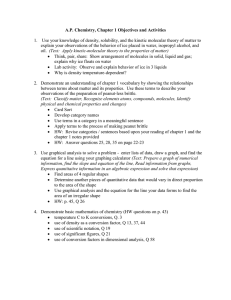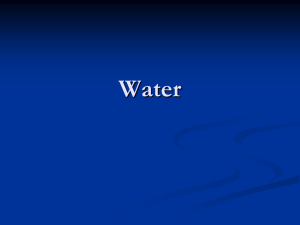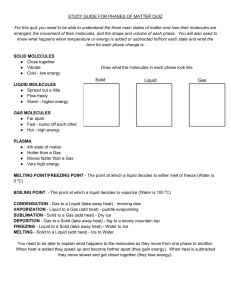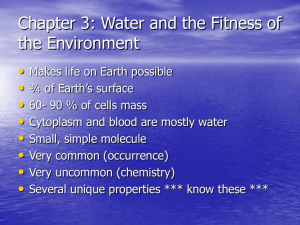Water & life
advertisement
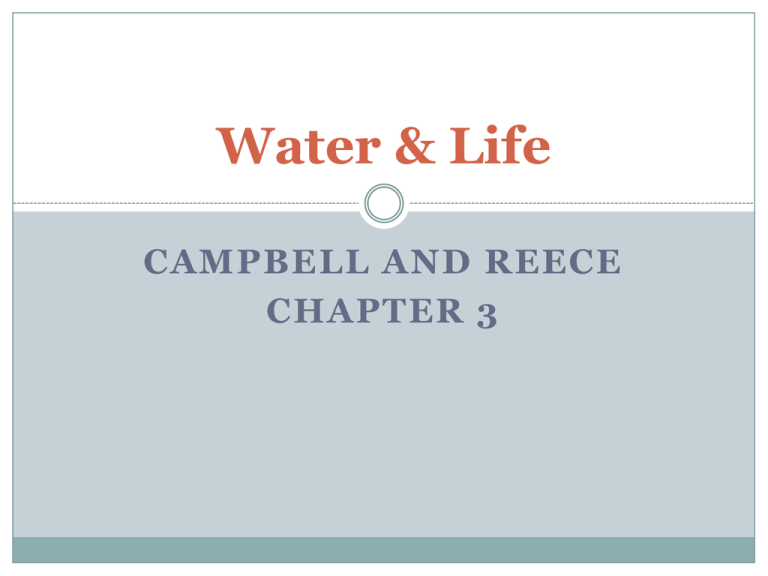
Water & Life CAMPBELL AND REECE CHAPTER 3 Hydrogen Bonding 2 characteristics contribute to H- bonds 1. polar covalent bond between H & O 2. molecule is bent (V-shaped) Water in Liquid State H-bonds ~ 1/20th as strong as covalent bond bonds constantly being formed/broken (each lasts a few trillionth of a sec.) @ any given moment a substantial % of all water molecules are part of a Hbond H-bonds in Water 4 Emergent Properties of Water all 4 contribute to suitability for life on Earth 1. Cohesion 2. Moderation of Temperature by Water 3. Ice Floats 4. Water is Universal Solvent Cohesion of Water Molecules H-bonds hold water molecules together = cohesion (like molecules sticking together) contributes (with adhesion) to the transport of water & nutrients against gravity in plants Water & Nutrients Move up the Xylem Surface Tension a measure of how difficult it is to stretch or break the surface of a liquid Water has greater surface tension than most other liquids due to Hbonding Moderation of Temperature by Water Water moderates temperature by absorbing heat from air that is warmer and releasing stored heat energy to air that is cooler. Water can absorb or release a relatively large amount of heat with only a slight change in its own temperature. Citrus Trees Sprayed with Water to Prevent Frost Damage Heat & Temperature heat: a measure of matter’s total KE due to motion of its molecules (so heat depends on volume of matter) temperature: a measure of heat intensity; represents the average KE of its molecules regardless of volume Calorie the amt of heat it takes to raise the temperature of 1 g water 1 ºC or the amt of heat that 1 g water releases when it cools by 1ºC Kilocalories a kilocalorie (kcal): quantity of heat required to raise temperature of 1,000 g of water by 1ºC Food packaging calls a kcal “calorie” 1 joule (J) = 0.239 cal 1 cal = 4.184 J Specific Heat is the amt of heat that must be absorbed or lost for 1 g of the substance to change its temperature by 1ºC specific heat of water is high which explains its ability to stabilize temperature Specific Heat of Water 1 cal/g x ºC specific heat of water high compared to other materials, water changes its temperature less when it absorbs or loses a given amt of heat Specific Heat of Water due to H-bonding absorbed heat must 1st break all the Hbonds b/4 it increases the average KE of its molecules when temperature drops slightly, many additional H-bonds form releases additional energy in form of heat Water’s High Specific Heat allows water to absorb and store a large amt of heat from Sun & warm up only a few degrees @ night & during winter the gradually cooling water warms the air Water’s High Specific Heat the water that covers most of Earth keeps temperature fluctuations on land & water w/in limits to permit life on Earth Moderating Effects of Large Bodies of Water on Temperatures Evaporative Cooling temperature is average KE of molecules some evaporization of water occurs @ any temp because some individual molecules of water my gain enough KE to gas phase Heat of Vaporization = quantity of heat a liquid must absorb for 1 g liquid phase gas phase water has high heat of vaporization relative to most other liquids because of H-bonding: absorbed energy must 1st break H-bonds, then increase KE of molecules High Heat of Vaporization of Water Global scale: helps moderate Earth’s climate Evaporative Cooling = as liquid evaporates the surface of the liquid that remains cools down contributes to stability of temperature in lakes & ponds provides mechanism to keep terrestrial organisms from overheating Evaporative Cooling Ice Floats water one of few substances that is less dense in its solid phase than in its liquid phase water expands when goes from liquid solid > 4ºC water acts like other liquids: expands as it warms up, contracting as it cools Ice Floats important factor in suitability of Earth’s environment to life if ice sank: lakes & ponds (even oceans) could freeze solid (from bottom to top) with summer temps only top upper meter or so would melt Ice Floats so ice insulates water below it, preventing it from freezing & allowing life to exist under frozen surface Global Warming average air temperature in Arctic has increased by 1.4ºC in the 50 years from 1961 -2011 ice forms later in fall and melts earlier to cover smaller area Water: Solvent of Life aqueous solution: one in which water is the solvent water is best solvent on Earth because … water is polar Water as Solvent salt in water dissociates and each cation and anion is surrounded by water molecules called a hydration shell Water as Solvent sea water & cytosol in cells contain variety of ions all in hydration shells polar molecules dissolve in water sugars proteins surface with ionic or polar regions on Hydrophilic Substances any substance that has an affinity for water substances too large to dissolve but still hydrophilic remain suspended in aqueous liquid (a colloid) Hydrophobic Substances nonionic, nonpolar substances repel water Molecular Mass/Moles sum of masses of all the atoms in a molecule not practical to use #s of molecules so use moles (mol) 1 mole = 6.02 x 10²³ Molar Mass molecular mass of glucose is 144 daltons 6.02 x 10²³ daltons in 1 g so molecular mass of glucose can be written as 144g in 1 mole of glucose measuring in moles allows you to combine substances in fixed ratios of molecules Molarity 1 mole of glucose in 1 liter water = 1-molar or 1M solution of glucose Molarity: the # of moles of solute per liter of water (for aqueous solutions) Water on Mars Astrobiologists have looked for life elsewhere based on: Is water present? Mars has polar ice caps, ice under surface and enough water vapor in atmosphere to form frost still looking for life…. Dissociation of Water Dissociation of Water Molecules only 1/554 million molecules of water are dissociated (in pure water) @ 25ºC the concentration of H+ or OHis 10-¹ M concentration of H+ or OH- is very low but they are each very reactive pH Scale Acid a substance that increases the [H+] overall has more H+ than OH- Base a substance that reduces the [H+] overall has more OH- than H+ pH Scale bases: 1. reduce [H+] by accepting H+ or 2. reduce [H+] indirectly by contributing OH- Weak Acids Form Reversible Reactions pH Scale In any aqueous solution @ 25ºC, the product of [H+] x [OH-] = 10ˉ¹ the pH scale compresses the range of H+ and OHˉ concentrations by using logarithms pH = the negative logarithm of [H+] or pH = -log [H+] pH Scale pH < 7.0 = acid pH > 7.0 = base most biological solutions are pH 6-8 exceptions: Each stomach acid is pH pH unit = 10x differences in [H+] or [OHˉ] (pH of 4 has 100x more H+ than pH of 6) Buffers molecules that are able to resist changes in pH consists of an acid-base pair that combines reversibly with H+ when H+ in excess & donate H+ when they have been depleted Buffers Buffers Acidification burning fossil fuels increases CO2 in atmosphere CO2 dissolves in water fresh water & sea water pH decreases Acidification of Oceans Acid Precipitation rain, snow, sleet, fog with a pH < 5.2 normal rain has pH 5.2 adversely affects: 1. life in ponds & streams 2. land plants 3. soil chemistry Acid Precipitation
